Sun Aug 04 2019 · 12 min read
Zones of Entrapment: Yerevan’s 2800th Anniversary Park and the Tyranny of Taste-Fullness

By Vigen Galstyan

There is no denying the ecstatic cries of the children and the content faces of their parents who have been flocking with their families to the newly inaugurated 2800th Anniversary Park of Yerevan. The mosaic-laden, grid of fountains, benches and astonishingly schmaltzy statues is a massive success. The general jolliness of the public inadvertently silences those naysayers who decry the supposed ‘tastelessness’ of the park. Just like the derided Northern Avenue, this new initiative by the city’s municipality - realized through the auspices of private capital - has given Yerevan’s residents a much-needed stretch of public space where people can socialize in relative comfort and safety. So what is the issue here and is there an issue at all? If we were to strip back the layers of meaning and intent in this site, what we’d find hidden is not so much herd mentality and tastelessness, but quite the opposite. This park, along with its even more grotesque twin – the recently reconstructed Central Avenue square adjoining Mashtots Avenue – are taste-full. Overwhelmingly so, in fact.
To put it crudely, ‘good taste’ is a historical and cultural phenomenon that evolved in the Western world during the early modern period in the 17th century and served as a way of delineating the aesthetic judgement of the nobility and the upper classes, from that of the ordinary folk. Possessing ‘good taste’ meant being aligned with superior levels of power and political standing – a position reflected through luxurious material objects and richly decorated residences. While it transformed dramatically during the 19th and especially 20th century, the concept of ‘good taste’ was always decried by Marxists and the artistic avant-garde as the epitome of petit bourgeoisie, and was passionately fought through the standardization of mass-culture and lifestyle in communist republics such as Soviet Armenia. Nevertheless, the ambition for social elevation remained an undercurrent drive that exploded with untamed force after the collapse of the USSR. This repressed desire to show one’s ‘taste’ in fine things – and hence, higher social ranking – was reflected in every aspect of everyday, post-Soviet Armenian life: from the extraordinary number of luxury cars to the neo-imperial style of the gargantuan private and public buildings constructed in the last two decades. The two newly reconstructed parks in Yerevan’s center boldly extend this tendency into the development of public space. Attendant political, sociological and cultural implications of such conversions have been ignored by the popular media and despite some critical reactions, the local intelligentsia has passively shrugged the matter away.[1] The present article is an attempt to continue the discussion and examine the wider consequences behind the relentless subjugation and transformation of existing public spaces in Yerevan, under the auspices of private capital and neo-liberal cultural policies.
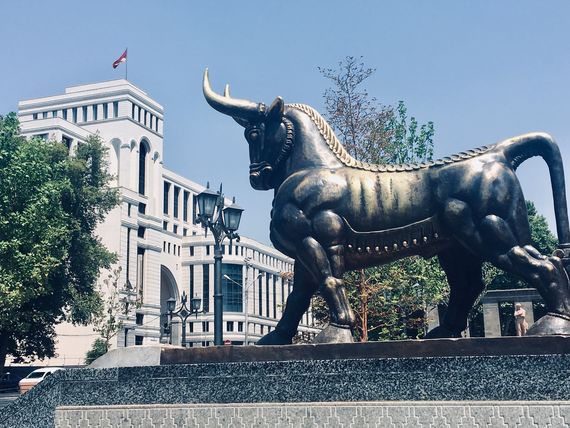
Statue at the entrance of the park. In the background: statue of Stepan Shahumyan and the new building hosting a number of ministries.
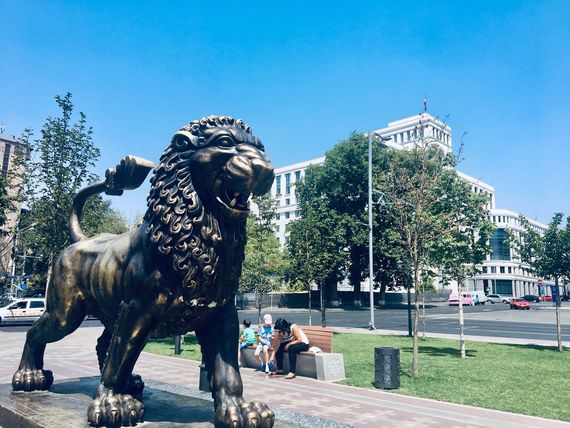
Statue at the entrance of the park.

Rendering of the 2800th Anniversary Park plan with mosaic floor and fountains.
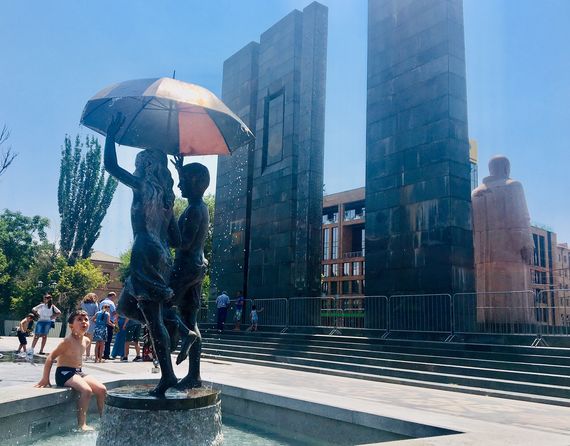
The 2800th Anniversary Park seen from the from behind the raised podium of Alexander Myasnikyan's statue.
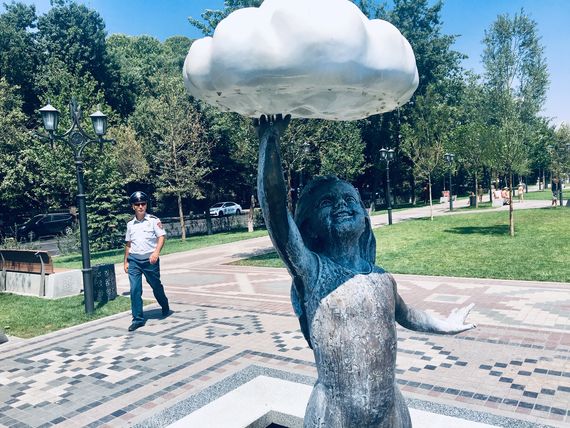
One of the several plaster statues in 2800th Anniversary Park.
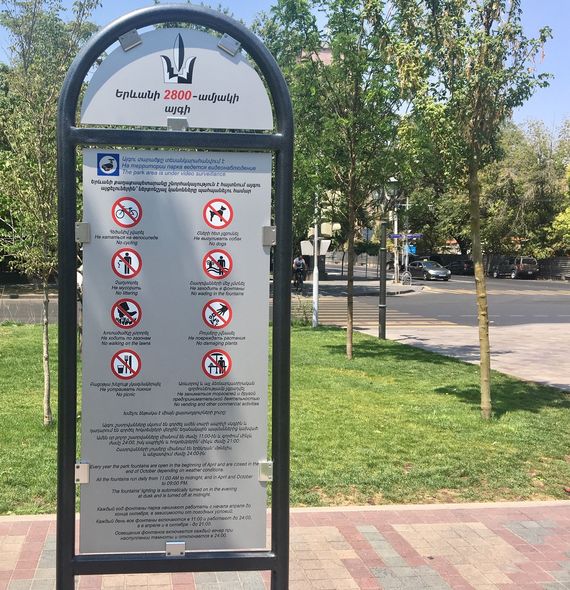
One of the signs in the park, "No cycling, no dogs, no littering, no wading in the fountains, no walking on the lawns, no damaging plants, no picnics, no vending and other commercial activities."

Children playing in the fountains at the park.
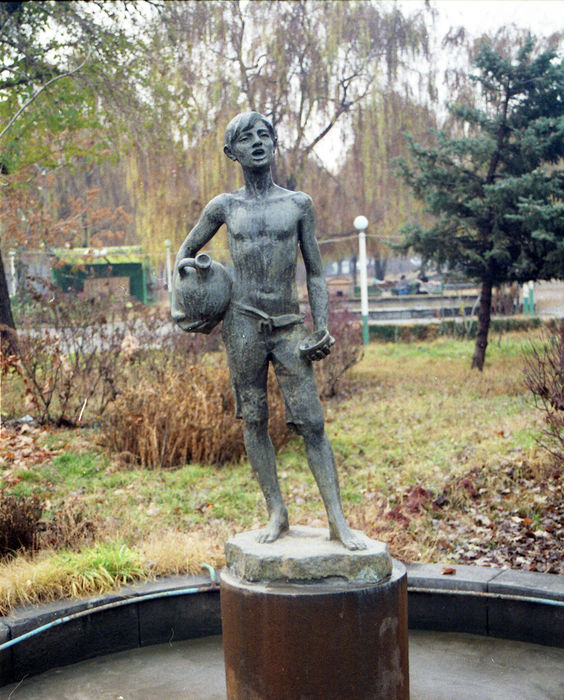
The statue of the ‘water-seller boy’ by Hovhannes Bedjanyan. Image courtesy of the author.
When on December 26, 2018, Yerevan’s Council of Elders approved a proposal to redevelop the neglected patch of green zone between the monuments to Bolshevik revolutionaries Stepan Shahumyan and Alexander Myasnikyan, the initiative generated a wave of public disapproval and protests by various activist groups.[2] The protests were fueled in part by the ongoing processes of the ‘Velvet Revolution’ and used the Park’s renovation as an occasion to demand the ousting of a key figure of the ‘old regime’ - the derided city Mayor Taron Margaryan. The issue was twofold: on the one hand, the park’s reconstruction intended to destroy dozens of existing and healthy trees, while on the other, it proposed to turn this very neutral space into a symbolically overladen and garishly designed ‘memorial’ dedicated to the 2800th anniversary of Yerevan.
Opinions were divided from the beginning. Once part of the ‘English Park’ – Yerevan’s oldest, European-style public space founded in the 1860s – this alleyway was redesigned sometime in the 1970s as modest grove of willow trees outfitted with plain wooden benches. As a kind of an ‘empty’ stretch between the adjoining Children’s Park and the English Park , it had become dilapidated after the construction of Beirut street in the 2000s. Gradually, it metamorphosed into a seedy afternoon meeting place for young lovers and a pick-up point for trans prostitutes and drug dealers at night. In short, the depressively tattered park was not a place anyone would take their kids to and many were all too happy to see it transformed into a gleaming concrete square with a row of fountains one usually finds around American malls.
Presented as a ‘gift’ to the capital’s inhabitants, the reconverted park became an ideal blanketing project for Taron Margaryan and the ruling Republican party, who were continuously criticized for the way they pillaged, sold and destroyed an astonishingly large section of Yerevan’s public spaces. Funded by the Vardanyan Family Foundation – a charity organization established by one of Armenia’s most powerful businessmen, confectionary magnate Hrant Vardanyan – the restoration project appeared like a model effort of neo-liberal, capitalist philanthropy. Despite initial fears, the park did not pursue any direct commercial, money-spinning agendas and seemed like an entirely earnest gesture of benevolence towards the ‘people’ by the local economic elite.
But this gesture veiled in plain sight what essentially amounted to an even more nefarious appropriation: the co-option of cultural capital and historical narratives for the validation of corporate venture. Vardanyan’s primary business arm, the confectionary company ‘Grand Candy’, has spawned a massively successful public image built on nostalgia, sugar-coated spectacle and the infantilization of cultural memory. In one of the company’s most loved TV ads, a young millennial couple suddenly find themselves thrown back to their (or more likely their parents) carelessly happy Soviet childhood when they taste Grand Candy’s ice-cream cups – a refashioning of the most ubiquitous ice-cream brand in the USSR.[3] Such commodification of the past as a consumable fantasy is nothing new in neo-liberal capitalist economy. This fetishization and mystification of history by corporate (and state) bodies has produced a powerful mechanism, which according to author Kevin Hetherington, is premised on a ‘wish image that capitalism… makes its own and turns into a deceiving phantasmagoria in the expression, above all, of progress.’[4] In other words, the capitalist system operates a dual process whereby it actively erases historical traces and memory, only to regurgitate its fragments as a purportedly ‘new’ products for the market.
To see a clear illustration of this procedure, it is merely sufficient to ‘unpackage’ the details out of which the 2800th Anniversary Park is constructed of. Take for example the mosaic floor fashioned after traditional Armenian carpets. In his analysis of the park’s design, art historian Vardan Azatyan focuses on this specific element, deconstructing the relationship between public gardens and carpets in urban environments. According to Azatyan, the carpet was a traditional means of visually and sensually recreating the experience of nature within the home, while the modern city offered that same artificial recreation on a monumental scale: ‘The city park is the citizen’s carpet’.[5] Following this logic, the inlaid carpet-mosaic of the 2800th anniversary park was like ‘picturing a carpet on a carpet, in order to assure oneself that one has a carpet’.[6]
Azatyan’s critique of the semantic ignorance that underlies this new public project is to the point. But this is not just a case of illiteracy. The supposed valorization of traditional culture and folklore is also a ruse, through which the driving agents of neo-liberal economy posit themselves as ‘guardians’ of national spirit, collective values and beliefs. Thus the public is reassured that they are, in fact, witnessing an uninterrupted narrative of cultural continuity in which the right-wing conservative governments and the economic elite play a decisive role. This sense of historically rooted ‘progressivism’ – so fundamental for the entire span of Armenian modernity – is reflected in the way the 2800th Anniversary Park mixes signifiers of Armenian cultural identity with hi-fi technological spectacle: automated irrigation system, computer-programmed ‘coloured’ fountains, an opulence of diverse construction materials and, naturally, 24 hour surveillance with guards and cameras.
In reality, this techno-traditionalist simulation works to obscure not only its deeply regressive nature, but also its profoundly ahistorical character. The bland but relatively neutral green zone preceding the Anniversary Park was a manifestation of some of the most progressive philosophical ideas that defined the last stage of Soviet modernity. Though bookended with two enormous monuments to communist leaders, this was a public space reasonably unburdened by ideological doctrine, allowing for social exchange to flow in comparative freedom. As a vivid example of anti-bourgeois resistance to ‘taste’, the park was a catalyst for interaction between diverse groups, who could regulate the shared space on their own terms, rather than via prescribed disciplinary frameworks. It is these possibilities of individual freedom, public trust and social equality, which made this small stretch of green so radically ‘modern’.
Meanwhile, the 2800th Anniversary conversion gives the public something entirely different. With its symmetrical plan and medium-sized new trees, the park is a cacophony of symbols, images, patterns and texts. Like an open palm, it holds everyone in plain sight with the raised podium of Alexander Myasnikyan statue acting as a lookout point from which the entire area can be observed like a giant kindergarten yard. This panopticon-like effect is strengthened by the presence of guards, surveillance cameras and the many signs which strictly police what the citizens can and cannot do (no dogs, no picnics, no alcohol, no lying on the grass, no bicycles, etc…). Such constraints upon visitor movement enable a docile social mass with prescribed behavioral regiment. Transgressions are curtailed on their own by this self-policing organism, with the mausoleum-like park acting as a barometer of public propriety.
In other words, the 2800th Anniversary Park is a display case – or an arena – where the public is drawn to perform an idealized version of itself: a utopia of a ‘perfect’ society. It is in this instance that the carpet-garden metaphor becomes particularly striking. For, in the Armenian cultural tradition, the carpet is not an allegory of just any garden, but of the lost paradise. Deliberately, or not, the 2800th Anniversary Park plays on this associative iconography with its emphasis on morally coded, ‘contained pleasure’. Thus, the ethno-ecclesiastical model of the family unit is the only one that appears befitting this setting in which individuals come together only to institute sameness and homogeneity. This is not a case of ‘shared cultural values’ as the park does not invite individuals to freely use, interpret and find personal associations with its environment. Instead, the visitor is imposed a formal regiment that invokes the parochialism of nationalist meta-narratives that have little basis in historical fact. In actuality, the symbolic order espoused by the park’s decorative solutions is as fake, as the cloying plaster statues placed next to the fountains. The sham ‘unity’ of disconnected signs – from Urartian mythological creatures, Christian carpets and medieval peasant pots, to the monuments of communist leaders, naturalistic plaster statues and neon-lit fountains – produces a schizophrenic phantasmagoria that can only be taken as evidence of Jean Baudrillard’s theory of ‘hypperreality’: the overcoming of the Real by virtual fantasy.[7]
Nominally meant to represent the complex and conflicted transformation of Yerevan into Armenia’s capital over three millennia, the fusion of incompatible architectural and decorative elements not only erases the specific cultural and political import of these signs, but turns the idea of Civilization into a metaphysical (and spectacular) ruse. From this perspective, the 2800th Anniversary Park shares strong affinities with the public spaces of the Stalinist era - exemplified by the VDNKH complex in Moscow – as well as the gaudy fantasies of California’s amusement parks. Both of these models operate at the extreme pitch of exaggeration, as monumental manifestations of tyrannical ideologies and beliefs. But as Baudrillard has famously noted, sites like Disneyland masquerade as benevolent fiction only to hide the truth that the surrounding reality is actually cut from the same cloth, and is also a series of simulations and decoys.[8] The condition of childish naiveté one allows oneself to experience in these amusement parks, does not end when one leaves these places, but extends far beyond into in the everyday. Disneyland only serves to cover up this lack of difference and the fact that all of America is, in fact, Disnelyand.
Following this logic, Yerevan’s 2800th Anniversary Park also ‘covers-up’ the fact that it is more of a ruin than the rundown patch of greenery which it came to replace. A ruin of meanings, narratives and functions. For nothing here really signifies what it purports to infer: from featureless plaster statues painted ‘a la bronze’ to the decorative function of trees that do anything but create shade and coolness (people bring umbrellas instead). And the still-relevant, Enlightenment-era conception of the public park as a zone where ‘the human spirit could experience a sense freedom and release from absolutist and clerical chains’, comes completely undone in the monitored environment of this trap-like stage. The tiny fountain-beds in which children joyfully jump into during the scorching summer days are more an offensive parody of the numerous public, open-air pools and ‘watering holes’ in Yerevan, which were wiped out en masse since 1991. In a ghastly display of open cynicism, the designers have removed the poignant 1970 statue of the ‘water-seller boy’ by Hovhannes Bedjanyan, only to replace it with the unnerving effigy of a non-descript smiling boy, sailing a paper boat made out of the famous ‘Soviet Armenia’ newspaper.
In effect, this new urban project is akin to a giant baby pacifier. Shiny and smooth, it bedazzles the public with the promise of ‘newness’ and ‘satisfaction’, while working to mollify the wave of dissent arising in response to the fleecing of Yerevan’s free zones. Long accustomed to such ransacking, the citizens have embraced this sugar-coated Trojan horse, like a desperate swarm of flies. The ensuing ‘happiness’ effect helps to dim awareness about Yerevan’s inability to provide its citizens with the basic means for forming connections, memories and communities within spaces outside of capitalism’s autocracy. Instead, areas such as the 2800th Anniversary Park ensure that every interaction with the city ultimately becomes a means of control and subjection.
Eavesdropping a local woman half-jokingly, but earnestly explain to her guests that the row of fountains is ‘our Yerevan sea’, it becomes clear that perhaps the most damaging affect of these speculative spaces is the way they exploit the basic needs and desires of citizens in order to pervade their sense of collective identity. The stream of selfies and group photos that the new parks are inherently designed for, will be shared on social media as fodder for virtual lives. The immediate gratification of these mindless exchanges comes to replace the supposedly liberating, embodied experiences, which parks and communal spaces in general, are meant to nurture and fuel.
In the context of autocratic, oligarchic or committedly neo-liberal regimes which continually propagate this coercive and incarcerating model of urban planning, the multiplication of such spaces is organic. Their proliferation and patronage by government bodies is less than understandable, however, in the post-revolutionary realities such as the one in Armenia. The truth of the matter may be that the insidious relationship between power, popular taste and the blinding hyperreality of these sites is perhaps too comfortable a fit to relinquish. After all, power, just like the 2800th Anniversary Park, is a realm where everything seems, but isn’t.
---------------------------------------------------------------------
[1] Opposition towards the construction of the 2800th Anniversary Park prompted a small conference organized by the literary café-salon ‘Actual Club’ on 9th of June, 2018 in Yerevan. Entitled ‘Yerevan’s Ebbing Public Spaces’, it included short presentations by academics and activists alike on a wide range of pertinent subjects - from the 1920s search for a new, modern urban identity to current struggles by activist groups, to the significance of modern ruins as markers of memory. A brief essay by art historian Vardan Azatyan (cited below) provided a semiological analysis of the park in the larger context of Armenia’s tense relationship with modernization projects across the 20th and 21st centuries. Nevertheless, as both new parks quickly ingrained themselves as permanent fixtures of Yerevan’s urban landscape, these separate instances of critique never evolved into a fully-fledged public discourse, outside of occasional quips on the social media.
[2] ‘Activists Protest Felling of Healthy Trees in Park Renewal Project; Demand Yerevan Mayor’s Resignation’, 16 May, 2018, www.hetq.am, https://hetq.am/en/article/88956 (accessed 20.05.2019)
[3] The one minute ‘A Cup of Happiness’ was produced in 2017 and shot as a comedic narrative sketch. https://youtu.be/mbVdtcca7po (accessed 25.05.2019)
[4] Kevin Hetherington, Capitalism's Eye: Cultural Spaces of the Commodity, Routledge, London, 2011, p.86.
[5] Vardan Azatyan, ‘From Carpet to Park and Back: In the Thick of Modernity’s Tensions’ [in Armenian], 26.05.2018, www.arteria.am, (accessed 15.05.2019)
[6] Ibid.
[7] See Jean Baudrillard, Simulacra and Simulation, University of Michigan Press, Ann Arbor, 1994
[8] Ibid., pp.12-16
by the same author
Notre Heritage? The Uncomfortable Truths of Cultural Legacy in Peril
The fire that severely damaged the Notre Dame Cathedral in Paris highlighted how indispensable art is for humanity and exposed the fragility of all cultural legacy. It also indicated the profoundly unbalanced ways through which the global community has come to evaluate the intellectual production of different cultures and nations.
Shooting to Heal
Vigen Galstyan takes the reader on a journey spanning a century of Armenian women photographers who carved out their own individual spaces and honed a personal vision that spoke to urgent, collective questions, often speaking the unspeakable and approaching the unapproachable.


